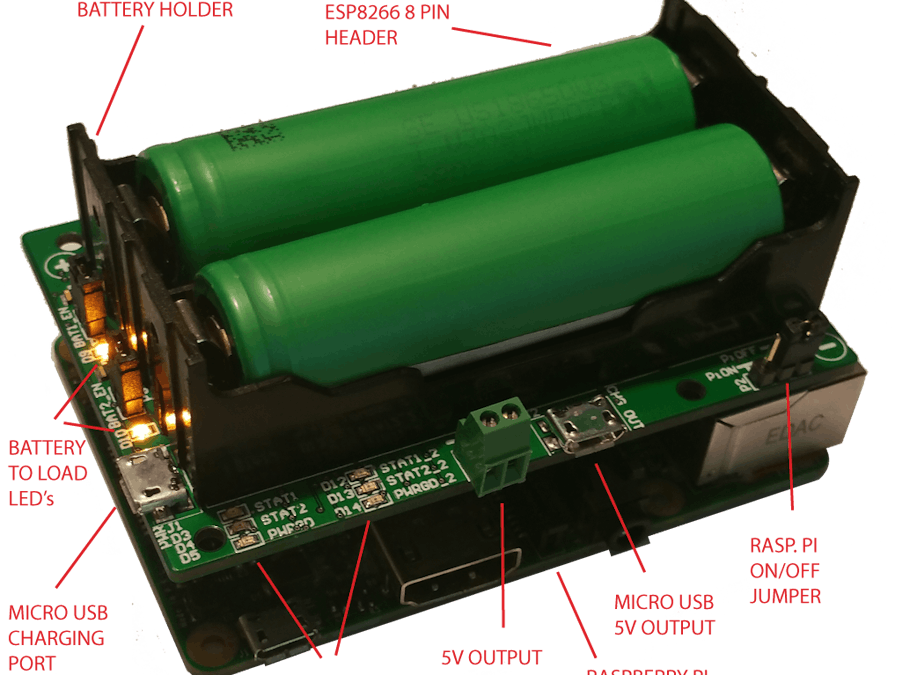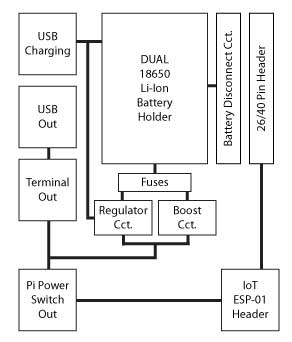import smbus
import time
from smbus import SMBus
import RPi.GPIO as GPIO
SAMPLES = 5.0
battery_capacity = 0.0
fuel_guage_temperature = 09.0
battery_voltage = 0.0
sample_delay = 0.005
BAT1_V_MON = 23
BAT2_V_MON = 24
GPIO.setmode(GPIO.BCM)
GPIO.setup(BAT1_V_MON, GPIO.OUT)
GPIO.setup(BAT2_V_MON, GPIO.OUT)
DEVICE_BUS = 1 #device bus number
DEVICE_ADDR = 0x64
DEVICE_REG_ADDR_ID = 0x00 #registry for device id ascii string 0x00 - 0x07
DEVICE_REG_ADDR_08 = 0x08
DEVICE_REG_ADDR_09 = 0x09
DEVICE_REG_ADDR_0A = 0x0A
DEVICE_REG_ADDR_45 = 0x45
#Fuel Gas Guage Monitor Registers
FUELGUAGE_ADDR = 0x64 #0b01100100
FUELGUAGE_REG_ADDR_00 = 0X00 #status (R) default()
FUELGUAGE_REG_ADDR_01 = 0X01 #control (R/W) default(3C)
FUELGUAGE_REG_ADDR_02 = 0X02 #acc charge MSB (R/W) default(7F)
FUELGUAGE_REG_ADDR_03 = 0X03 #acc charte LSB (R/W) default(FF)
FUELGUAGE_REG_ADDR_04 = 0X04 #charge threshold high MSB (R/W) default(FF)
FUELGUAGE_REG_ADDR_05 = 0X05 #charge threshold high LSB (R/W) default(FF)
FUELGUAGE_REG_ADDR_06 = 0X06 #charge threshold low MSB (R/W) default(00)
FUELGUAGE_REG_ADDR_07 = 0X07 #charge threshold low LSB (R/W) default(00)
FUELGUAGE_REG_ADDR_08 = 0x08 #voltage MSB (R) default(XX) unknown
FUELGUAGE_REG_ADDR_09 = 0x09 #voltage LSB (R) default(XX)
FUELGUAGE_REG_ADDR_0A = 0X0A #voltage threshold high (R/W) default(FF)
FUELGUAGE_REG_ADDR_0B = 0X0B #voltage threshold low (R/W) default(00)
FUELGUAGE_REG_ADDR_0C = 0X0C #temperature MSB (R) default(XX)
FUELGUAGE_REG_ADDR_0D = 0X0D #temperature LSB (R) default(XX)
FUELGUAGE_REG_ADDR_0E = 0X0E #temperature threshold high (R/W) default(FF)
FUELGUAGE_REG_ADDR_0F = 0X0F #temperature threshold low (R/W) default(00)
bus = smbus.SMBus(DEVICE_BUS)
class i2cCommand:
def __init__(self):
global SAMPLES
global battery_capacity
global fuel_guage_temperature
global battery_voltage
global sample_delay
global BAT1_V_MON
global BAT2_V_MON
global bus
global DEVICE_ADDR
global FUELGUAGE_ADDR
global DEVICE_REG_ADDR_ID
global DEVICE_REG_ADDR_08
global DEVICE_REG_ADDR_09
global DEVICE_REG_ADDR_0A
global DEVICE_REG_ADDR_45
global FUELGUAGE_REG_ADDR_00 #= 0X00 #(reg name A)
global FUELGUAGE_REG_ADDR_01 #= 0X01 #(reg name B)
global FUELGUAGE_REG_ADDR_02 #= 0X02 #(reg name C)
global FUELGUAGE_REG_ADDR_03 #= 0X03 #(reg name D)
global FUELGUAGE_REG_ADDR_04 #= 0X04 #(reg name E)
global FUELGUAGE_REG_ADDR_05 #= 0X05 #(reg name F)
global FUELGUAGE_REG_ADDR_06 #= 0X06 #(reg name G)
global FUELGUAGE_REG_ADDR_07 #= 0X07 #(reg name H)
global FUELGUAGE_REG_ADDR_08 #= 0X08 #(reg name I)
global FUELGUAGE_REG_ADDR_09 #= 0X09 #(reg name J)
global FUELGUAGE_REG_ADDR_0A #= 0X0A #(reg name K)
global FUELGUAGE_REG_ADDR_0B #= 0X0B #(reg name L)
global FUELGUAGE_REG_ADDR_0C #= 0X0C #(reg name M)
global FUELGUAGE_REG_ADDR_0D #= 0X0D #(reg name N)
global FUELGUAGE_REG_ADDR_0E #= 0X0E #(reg name O)
global FUELGUAGE_REG_ADDR_0F #= 0X0F #(reg name P)
GPIO.output(BAT1_V_MON, False) #set both n-chan mosfets to off for multiplexing I2C clk line
GPIO.output(BAT2_V_MON, False)
return None
def set_fuelguage_control_reg(self, adc_mode_bit7_6, prescaler_bit5_3, al_cc_bit2_1, shutdown_bit0):
#set bit7_6-11 (0xC0) for auto mode temp and volt convertion every 1 second
#bit7_6-10 (0x80) for manual volt mode
#bit7_6-01 (0x40) for manual temp mode
#bit7_6-00 (0x00) for sleep mode
#leave bit5_3-111 for prescaler default 128
#equation 2^(4*B5 + 2*B4 + B3) ie. 2^(4*1 + 2*1 + 1) = 2^7 = 128
#leave bit2_1-10 for output alert mode (can connect to pin on rasp pi compute module
#leave bit0-0 as the 3V3 power will be turned off by user, but current drain will not be monitored when 3V3 off
#hardcode for now
adc_mode_bit7_6 = 0xC0
prescaler_bit5_3 = 0x38
al_cc_bit2_1 = 0x04
shutdown_bit0 = 0x00
value = adc_mode_bit7_6 | prescaler_bit5_3 | al_cc_bit2_1 | shutdown_bit0
print "set_fuel_gauage_control_reg value: ", hex(value)
for i in range(2):
if i == 0:
print("Initializing Battery 1 Monitor")
GPIO.output(BAT1_V_MON, GPIO.HIGH)
GPIO.output(BAT2_V_MON, GPIO.LOW)
else:
print("Initializing Battery 2 Monitory")
GPIO.output(BAT1_V_MON, GPIO.LOW)
GPIO.output(BAT2_V_MON, GPIO.HIGH)
try:
bus.write_byte_data(FUELGUAGE_ADDR, FUELGUAGE_REG_ADDR_01, value)
except IOError as e:
print("Could not connect to battery monitor: (set_fuelguage_control_reg) "), i
'''
print "checking fuel_gauage_control_reg value: "
(device_str_ctrl) = bus.read_byte_data(FUELGUAGE_ADDR, FUELGUAGE_REG_ADDR_01)
print "ctrl reg: ", hex(device_str_ctrl)
'''
time.sleep(0.1)
return 0
def fuelguage_check_volt(self, battery_sel):
if battery_sel == 1:
GPIO.output(BAT1_V_MON, GPIO.HIGH)
GPIO.output(BAT2_V_MON, GPIO.LOW)
elif battery_sel == 2:
GPIO.output(BAT1_V_MON, GPIO.LOW)
GPIO.output(BAT2_V_MON, GPIO.HIGH)
else:
GPIO.output(BAT1_V_MON, GPIO.LOW)
GPIO.output(BAT2_V_MON, GPIO.LOW)
#voltage is 14bit (reg's I and J) and temperature 10bit (reg's M and N)resolution
#convert I and J to 16bit variable, then (value / 65535) x 6V = Voltage
#read registers I and J (8 and 9 sequentially)
voltage_msb = float(0.0)
voltage_lsb = float(0.0)
temp_msb = float(0.0)
temp_lsb = float(0.0)
#all_regs = bus.read_i2c_block_data(FUELGUAGE_ADDR, FUELGUAGE_REG_ADDR_08, 16)
#status, control, acc_msb, acc_lsb, chrgthhi_msb, chrgethhi_lsb, chrgthlow_msb, chrgthlow_lsb, voltage_msb, voltage_lsb, voltth_msb, voltth_lsb, temp_msb, temp_lsb, tempth_msb, tempth_lsb = all_regs
#print "all regs1: ", all_regs
battery1_status_flag = 0
battery2_status_flag = 0
try:
voltage_msb = SMBus(1).read_byte_data(DEVICE_ADDR, FUELGUAGE_REG_ADDR_08)
voltage_lsb = SMBus(1).read_byte_data(DEVICE_ADDR, FUELGUAGE_REG_ADDR_09)
#print "voltage_msb: ", voltage_msb
#print "voltage_lsb: ", voltage_lsb
temp_msb = SMBus(1).read_byte_data(DEVICE_ADDR, FUELGUAGE_REG_ADDR_0C)
temp_lsb = SMBus(1).read_byte_data(DEVICE_ADDR, FUELGUAGE_REG_ADDR_0D)
#print "temp_msb: ", temp_msb
#print "temp_lsb: ", temp_lsb
if battery_sel == 1:
battery1_status_flag = 1
else:
battery2_status_flag = 1
except IOError as e:
print("Could not read to battery voltage monitor: "), battery_sel
if battery_sel == 1:
battery1_status_flag = 0
else:
battery2_status_flag = 0
#(voltage_reg_I_J) = bus.read_i2c_block_data(FUELGUAGE_ADDR, FUELGUAGE_REG_ADDR_08, 2)
#voltage_msb = bus.read_byte_data(FUELGUAGE_ADDR, FUELGUAGE_REG_ADDR_08)
#voltage_lsb = bus.read_byte_data(FUELGUAGE_ADDR, FUELGUAGE_REG_ADDR_09)
#print "voltage_reg_I_J: ", voltage_reg_I_J
#voltage_msb, voltage_lsb = voltage_reg_I_J
#print "voltage_msb: ", voltage_msb
#print "voltage_lsb: ", voltage_lsb
if (battery_sel == 1 and battery1_status_flag == 1) or (battery_sel == 2 and battery2_status_flag == 1):
voltage_16bit = float(0.0)
voltage_msb = voltage_msb << 8
#print "voltage_msb: ", hex(voltage_msb)
#print "voltage_lsb: ", hex(voltage_lsb)
voltage_16bit = float(voltage_msb | voltage_lsb)
#print "voltage_16bit: ", voltage_16bit
#voltage at battery
battery_volt = float(0.0)
divisor = float(65535.0)
multiplier = float(6.0)
battery_volt = ( voltage_16bit / divisor ) * multiplier
##print "battery_volt: ", battery_volt
battery_capacity_percent = 0
#battery capacity reference table
if battery_volt >= 4.20:
battery_capacity_percent = 100
elif battery_volt < 4.20 and battery_volt >= 4.15:
battery_capacity_percent = 98
elif battery_volt < 4.15 and battery_volt >= 4.10:
battery_capacity_percent = 95
elif battery_volt < 4.10 and battery_volt >= 4.00:
battery_capacity_percent = 85
elif battery_volt < 4.00 and battery_volt >= 3.95:
battery_capacity_percent = 75
elif battery_volt < 3.95 and battery_volt >= 3.90:
battery_capacity_percent = 65
elif battery_volt < 3.90 and battery_volt >= 3.85:
battery_capacity_percent = 55
elif battery_volt < 3.85 and battery_volt >= 3.80:
battery_capacity_percent = 50
elif battery_volt < 3.80 and battery_volt >= 3.75:
battery_capacity_percent = 48
elif battery_volt < 3.75 and battery_volt >= 3.70:
battery_capacity_percent = 44
elif battery_volt < 3.70 and battery_volt >= 3.65:
battery_capacity_percent = 38
elif battery_volt < 3.65 and battery_volt >= 3.60:
battery_capacity_percent = 36
elif battery_volt < 3.60 and battery_volt >= 3.55:
battery_capacity_percent = 34
elif battery_volt < 3.55 and battery_volt >= 3.50:
battery_capacity_percent = 31
elif battery_volt < 3.50 and battery_volt >= 3.45:
battery_capacity_percent = 29
elif battery_volt < 3.45 and battery_volt >= 3.40:
battery_capacity_percent = 26
elif battery_volt < 3.40 and battery_volt >= 3.35:
battery_capacity_percent = 24
elif battery_volt < 3.35 and battery_volt >= 3.30:
battery_capacity_percent = 23
elif battery_volt < 3.30 and battery_volt >= 3.25:
battery_capacity_percent = 21
elif battery_volt < 3.25 and battery_volt >= 3.20:
battery_capacity_percent = 18
elif battery_volt < 3.20 and battery_volt >= 3.15:
battery_capacity_percent = 16
elif battery_volt < 3.15 and battery_volt >= 3.10:
battery_capacity_percent = 15
elif battery_volt < 3.10 and battery_volt >= 3.05:
battery_capacity_percent = 11
elif battery_volt < 3.05 and battery_volt >= 3.00:
battery_capacity_percent = 10
else:
battery_capacity_percent = 0
##print "battery_capacity_percent: ", battery_capacity_percent
#temperature conversion to celcius ------------------------------------------------
#print "temp_msb: ", temp_msb
#print "temp_lsb: ", temp_lsb
temperature_16bit = float(0.0)
temp_msb = temp_msb << 8
#print "temp_msb: ", hex(temp_msb)
temperature_16bit = float(temp_msb | temp_lsb)
#print "temperature_16bit: ", temperature_16bit
#voltage at battery
temperature_kelvin = float(0.0)
temperature_multiplier = float(600.0)
temperature_kelvin = ( temperature_16bit / divisor ) * temperature_multiplier
##print "temperature_kelvin: ", temperature_kelvin
temperature_celcius = float(0.0)
temperature_celcius = temperature_kelvin - 273.0
##print "temperature_celcius: ", temperature_celcius
elif (battery_sel == 1 and battery1_status_flag == 0) or (battery_sel == 2 and battery2_status_flag == 0):
print("No measurements available for battery: "), battery_sel
battery_volt = 0.0
battery_capacity_percent = 0
temperature_celcius = 0.0
return battery_capacity_percent, temperature_celcius, battery_volt
testpoll = i2cCommand()
testpoll.set_fuelguage_control_reg(0xC0, 0x80, 0x10, 0x00)
while 1:
battery_capacity = 0.0
fuel_guage_temperature = 0.0
battery_voltage = 0.0
battery_capacity_temp = 0.0
fuel_guage_temperature_temp = 0.0
battery_voltage_temp = 0.0
for i in range(int(SAMPLES)):
battery_temperature = testpoll.fuelguage_check_volt(1) #1 for battery 1,
battery_capacity_temp, fuel_guage_temperature_temp, battery_voltage_temp = battery_temperature
battery_capacity = battery_capacity + battery_capacity_temp
fuel_guage_temperature = fuel_guage_temperature + fuel_guage_temperature_temp
battery_voltage = battery_voltage + battery_voltage_temp
time.sleep(sample_delay)
battery_capacity = battery_capacity / SAMPLES
fuel_guage_temperature = fuel_guage_temperature / SAMPLES
battery_voltage = battery_voltage / SAMPLES
print "-----------------------------------------------"
print "Battery 1:"
print "Battery Capacity Percent: ", battery_capacity
print "Fuel Guage Temperature: ", fuel_guage_temperature
print "Battery Voltage: ", battery_voltage
time.sleep(2.0)
print "-----------------------------------------------"
battery_capacity = 0.0
fuel_guage_temperature = 0.0
battery_voltage = 0.0
battery_capacity_temp = 0.0
fuel_guage_temperature_temp = 0.0
battery_voltage_temp = 0.0
for i in range(int(SAMPLES)):
battery_temperature = testpoll.fuelguage_check_volt(2) #1 for battery 2,
battery_capacity_temp, fuel_guage_temperature_temp, battery_voltage_temp = battery_temperature
battery_capacity = battery_capacity + battery_capacity_temp
fuel_guage_temperature = fuel_guage_temperature + fuel_guage_temperature_temp
battery_voltage = battery_voltage + battery_voltage_temp
time.sleep(sample_delay)
battery_capacity = battery_capacity / SAMPLES
fuel_guage_temperature = fuel_guage_temperature / SAMPLES
battery_voltage = battery_voltage / SAMPLES
print "-----------------------------------------------"
print "Battery 2:"
print "Battery Capacity Percent: ", battery_capacity
print "Fuel Guage Temperature: ", fuel_guage_temperature
print "Battery Voltage: ", battery_voltage
time.sleep(2.0)
print "-----------------------------------------------"
print "*************************************************************************"
print "*************************************************************************"









Comments